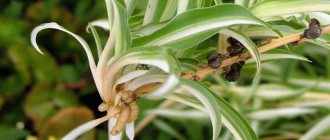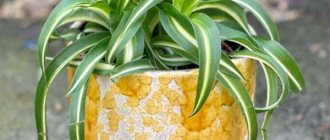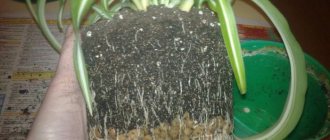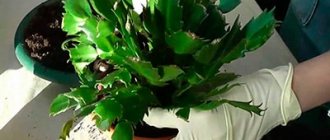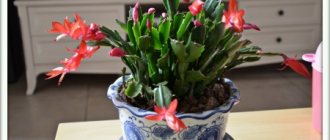- October 31, 2018
- Miscellaneous
- Marina Nikolaeva
Once upon a time, no more than twenty years ago, chlorophytum was one of the most popular indoor plants. It could be seen in almost every room of a house or apartment - in bright rooms, dark corridors, and the kitchen. This flower also decorated government institutions: in sanatoriums and hospitals, this tropical guest was comfortably located in the hallways; in schools, pots with it hung or stood in classrooms and corridors.
Unfortunately, today chlorophytum is undeservedly forgotten. In our opinion, it is completely in vain. The plant has remarkable decorative characteristics, does not require complex care, and is perfect for beginners who love indoor plants to gain experience. In this material we will tell you about this ornamental plant - how to care for it, water it, and how to replant chlorophytum.
Historical reference
An ornamental deciduous herbaceous plant - chlorophytum is a perennial epiphyte. In other words, in nature it grows on other plants without receiving nutrients from them. Initially, it was classified as a member of the Lily perennial family. Modern researchers do not have a consensus on this matter. One group of scientists classifies chlorophytum as a member of the Agave family, and another group as one of the Asparagus family.
Europeans learned how to grow chlorophytum more than 200 years ago, when plants were brought to the continent from the humid subtropics and tropics of Asia, Africa and South America. It is known that the brilliant German writer and philosopher Johann Goethe himself grew it in his home in hanging containers and always admired the spectacular appearance of the plants and the charming little children that hung around the mother bushes.
The name of the plant can be literally translated as “green plant.” In nature, in regions with high levels of humidity and heat, it is not easy for chlorophytum to survive. That is why this exotic guest feels so comfortable at home, giving the owner not only his beauty, but also useful and healing properties.
Useful properties of the plant
After numerous studies, scientists were able to prove that chlorophytum has a truly unique ability to remove formaldehyde, all kinds of toxins and impurities from the air around it. The phytoncides secreted by its leaves purify the air in the room from pathogenic microbes and saturate it with oxygen. It has been proven that in just a day, the flower kills about 80% of the bacteria in the air surrounding the bush. Three or four mature plants can easily clean a 10-square-meter room. m.
A flower placed on a kitchen windowsill absorbs harmful emissions from electrical and gas appliances. In the vicinity of pelargonium (indoor geranium), chlorophytum absorbs dust and microbes in rooms. For this feature it is often called a vacuum cleaner flower. The plant regulates the air humidity in the room and also improves its microclimate, since the leaf plates accumulate moisture and then release it into the surrounding atmosphere, being a kind of natural air humidifier.
By growing chlorophytum in your apartment, you can automatically improve your quality of life. This is especially important for people who suffer from bronchial asthma, allergies or low immunity.
External features of the plant
Chlorophytum has a short stem. The length of its leaves can vary depending on the variety. They are the longest (up to 60 cm or more) in hanging varieties. The narrow leaves with pointed ends have a linear-lanceolate shape, much less often – oval. They are collected in lush rosettes or bunches.
The bush grows in height and width approximately equally – by 50 cm. Cases have been recorded when an adult healthy plant grows up to a meter in height and in diameter, its leaves create magnificent cascades up to one and a half meters in length. On average, a perennial lives about 10 years.
Long shoots with aerial roots and small leaves grow from the center of the bush. In summer and spring, chlorophytum produces long, curved peduncles. At their ends appear small silvery-white star-shaped flowers, a bit like tiny lilies. They look very original against the background of long green or variegated leaves.
When the flowers fade, fruit boxes appear, as well as small rosettes with leaves and aerial roots. These are the children of chlorophytum. The flower has tuberous, thickened roots, colored brown or yellow. They can accumulate such an amount of moisture that the plant can live without watering or spraying for up to a month. In this case, your pet will lose its decorative appearance: the beautiful long leaves will fade and droop along the edges of the pot. However, the plant will not die, but will wait patiently until the owner remembers it. As soon as watering of chlorophytum is resumed, it will come to life again and very soon restore its attractiveness.
Answers to popular questions
Why do the leaves/shoots turn black or dry?
The very first reason is improper watering. Basically, this means that the plant is not getting enough moisture. Another common reason is that there is not enough space in the pot for the root system.
Why did the leaves droop?
This process also has natural reasons. For example, Chlorophytums lower their foliage slightly at night due to lack of light. But if the phenomenon is permanent, then most likely the flower is cold (room temperature +10 C or less).
Chlorophytum not blooming?
This is a double-edged sword, because everything depends on the variety. Very often it is really difficult to achieve Chlorophytum flowering. But if you choose a variety with constant flowering, then it is important to understand that young plants do not bloom for a long time. They need 2-3 years to reach adulthood.
What to do if the roots rot?
Basically, the main reason lies in poorly permeable soil. The situation can be corrected only by transplanting the flower into the correct soil (in this case, emergency measures are needed, so replanting can be done not only in the spring, but also at any other time of the year).
Why has growth slowed?
Perhaps the reason for everything lies in the small pot. Sometimes growth slows down if the flower lacks light or moisture.
The leaves are the same color, what should I do?
Variegated species can indeed sometimes grow with completely green foliage, losing their identity. Almost always, the main reason for this phenomenon is a lack of lighting. You should change the location of the plant or organize artificial supplementary lighting.
Types and varieties
Today there are more than two hundred species and varieties of this wonderful plant. However, only a few of them are common in indoor floriculture.
- Crested
It is a native of South Africa. Chlorophytum crested has long (up to 50 cm) saber-shaped leaves. White longitudinal stripes run along their edge. The leaves are collected in bunches, from the center of which arrows grow. They can be spread out or hanging, much less often - curly.
Daughter rosettes are formed at their ends. Initially, the leaves of this plant species were uniformly colored green. Later, varieties were developed with leaves decorated with longitudinal yellow-cream or white stripes in the center.
- Curly
This chlorophytum resembles a bush of dense grass with long and wider leaves that are covered with alternating light and dark green stripes. Hanging leaves curl at the ends. The flower looks very neat and compact. It forms simple inflorescences in the form of panicles.
- Winged (orange)
This species has unusually colored petioles on which the leaves are held. They are painted brick orange or orange-pink. The leaves are typical of chlorophytum - dark green and long. They taper towards the ends. As a rule, at home, propagation of this species of chlorophytum is carried out by seeds, much less often by root rosettes. The plant blooms with small orange flowers. Experienced flower growers recommend removing flower stalks in a timely manner so that the petioles do not lose their bright color.
Chlorophytum: home care
Perhaps this is the most resilient and unpretentious indoor flower known today. This is why it is suitable for beginner gardeners - you will get excellent practice and will not be disappointed with the result.
Caring for chlorophytum at home is extremely simple: the plant can withstand any conditions - a dark corner or a bright window, regular watering or moistening once a month. By its appearance, chlorophytum informs its owner about a mistake. Moreover, he will give you time to fix it, and if you take this chance, he will again thank you with a magnificent decorative look. Nevertheless, we will introduce you to the conditions that are most comfortable for this flower.
Conclusion
Chlorophytums are surprisingly unpretentious indoor plants and this is perhaps their most important advantage. This is what explains their great popularity, which even today has fallen, but is still high.
Chlorophytums are perfect for growing for beginners. But professionals will also be able to find a lot of interesting things for themselves if they give preference to rarer, more care-demanding, exotic varieties.
Lighting
For this light-loving plant, diffused lighting is quite comfortable. Chlorophytum grows and develops well in such conditions. He likes the location near western or eastern windows. It will also take root on a bright windowsill of a south-facing window, but in this case it should be slightly shaded at midday to protect the leaves from being burned.
Chlorophytum varieties with green leaves can grow even in dark corners. True, its flowers will not be as rich and smaller; in this case, the daughter rosettes develop less actively.
If you are interested in how to plant variegated chlorophytum, then it should be noted that it does not like too shaded places - quite quickly the bright stripes will disappear from the leaves and they will become monochromatic green.
Nuances of cultivation
In general, the plant is unpretentious. That is why novice gardeners choose it. But there are some nuances that are worth considering.
Why does he shoot an arrow?
The arrow is a method of reproduction. The flower shoots out its arrows more readily when the pot becomes quite cramped. Nature intended that the plant should leave offspring. Another condition is sufficient sun. In a very dark place, he may not shoot, because he does not have enough strength to do so. Timely feeding is also important.
What to do if it doesn't sprout?
A few recommendations to help reproduction:
- plant in a cramped pot;
- do not overfeed so that the plant does not “get fat”;
- put in a bright place;
- do not plant the bush until it becomes large enough;
- feed with fertilizers containing nitrogen;
- take a hot shower;
- Place in a hanging pot.
Watering the plant
Our exotic guest loves moist soil. Abundant and frequent watering of chlorophytum is recommended from spring to autumn. In winter, moderate soil moisture is sufficient. During the heating season, the earthen ball dries out quite quickly even in winter, so try to keep it moist, avoiding waterlogging.
Unlike the overwhelming majority of indoor plants, chlorophytum, without being capricious, drinks tap water, which is left to settle for 24 hours. If the plant lacks moisture, the leaves begin to dry out and the roots become covered with additional tuberous thickenings. When overwatered, if there is always water in the tray, the tips of the leaves of the chlorophytum turn black and its appearance deteriorates.
Common Mistakes
The following should not be allowed:
- Too much watering - the foliage becomes soft, turns yellow and falls off. If watering is not normalized, the flower will die.
- Frequent overdrying of the earthen coma means the foliage dries out.
- Placement in an area that is too dark.
- Placement on the south side of the house without additional shading.
- Planting a small cutting in a very large pot will slow down the growth of foliage, since all the energy will be spent on growing roots and filling the soil with them.
- A rare transplant or a cramped pot.
- Untimely removal of arrows.
Choosing a flower container
Which pot is needed for chlorophytum is determined only by the owner of the plant. Only he decides in what container it is more convenient to grow a flower - in a flowerpot, in a pot, hanging varieties - in wicker hanging baskets and flowerpots. Chlorophytum grows well even in hydroponics. The root system of this plant will easily master a pot of any size and type. The only factor to consider is that ceramic pots or thick-walled flowerpots are more suitable for mature plants. Plastic pots with thin walls cannot withstand the powerful pressure of the root system and burst.
Botanical description
We have just talked about the main advantage of chlorophytum - ease of cultivation and care. There are some other features that distinguish it from other plants:
- Chlorophytum blooms in March and blooms throughout the growing season;
- the plant's dormant period is from October to January;
- indoor chlorophytum grows well in hydroponics;
- sometimes, as a result of insufficient watering or too dry air, the tips of chlorophytum leaves dry out, and the plant to some extent loses its decorative effect;
- chlorophytum is good not only in a hanging basket or on a stand, it can even decorate a flower bed in the garden with its variegated leaves;
- Chlorophytum looks great both as a solo plant and in a group with other plants.
Soil selection
You don’t have to worry about what kind of soil is suitable for chlorophytum. The plant feels great in any universal soil composition for indoor plants. It is necessary that the substrate must be moisture-absorbing, well aerated and loose. In heavy soil, the plant most often slows down its growth, its root system is inhibited, and the above-ground part becomes less lush and elegant.
If you do not have the opportunity to buy ready-made soil, make it yourself from equal parts of leaf soil, turf soil, humus sand and peat.
Rest period
October-January is a mild period of rest. It is advisable to water the plant less often and not fertilize it. The temperature is several degrees lower.
In cold rooms, be especially careful about watering - do not overwater the plant to avoid root rot, and make sure that the temperature does not drop below +10°.
Chlorophytum roots before transplanting
Top dressing
Chlorophytum planted in soil for ornamental plants, as a rule, does not need feeding. However, experts recommend feeding chlorophytum twice a month in spring and summer with liquid fertilizer, which stimulates the plant to form daughter rosettes.
You will immediately notice from the faded and drying leaves that the composition of the soil mixture is too poor. Only weekly liquid feeding while watering the plant will help save the situation. Any complex fertilizer in the dose recommended by the instructions is suitable for this purpose.
How to transplant chlorophytum?
This perennial, which has a powerful root system, grows very actively. The roots of the plant quickly fill the container, displacing the soil. Therefore, it is important to know how to transplant chlorophytum. As a rule, this procedure is carried out in early spring. Prepare a pot in advance, 2-3 cm larger in diameter than the previous one.
Remove the plant from the pot, shake off the soil from the roots and, as far as possible, disassemble them with your hands and straighten them. Place a layer of drainage (2-4 cm) at the bottom of the new pot. Place the chlorophytum in a new container with fresh soil. While filling the pot with substrate, gently shake it to fill all the voids.
After replanting, chlorophytum should be watered abundantly so that all the soil is saturated. Drain excess moisture from the pan after some time. Place the plant in a place protected from sunlight. After three days you can move it to a permanent place.
It is possible to replant chlorophytum in the fall if you notice that the flower has become cramped in the pot. In a container that is too cramped, as well as in a container that is too spacious, the plant may refuse to bloom.
Transfer
There is nothing difficult with transplanting Chlorophytums. Firstly, this plant does not need it very often, but only as the container is filled with roots (this can be seen by the clearly stopped growth). Secondly, the process occurs through the usual transfer, that is, with the preservation of a clod of earth from the old pot and the addition of new fertile soil.
It is best to wait until early spring to transplant. Then you can sufficiently feed the plant and reduce stress for it, since a time of growth and enhanced root formation is expected ahead.
Chlorophytum transplant
Air babies
The simplest, and therefore the most popular, method of propagating chlorophytum. Although children greatly decorate the plant, an excessive number of them should be disposed of - too many offspring weaken the flower. You can root children year-round in one of three possible ways.
- Select the strongest rosette, carefully separate it from the mother plant with a disinfected sharp knife and place it in a glass of settled water for rooting. Soon the roots will appear and grow. When their length reaches 2 cm, transplant the young bush into the prepared pot. Overgrown roots are very brittle and fragile, they can easily be damaged during planting.
- Do not separate the selected strong and healthy shoot located at the end of the shoot from the bush. Bury it in a separate container placed nearby. When the baby takes root, the shoot needs to be cut off.
- If for some reason you don’t like this method, then you can cut off the baby from the frog and immediately bury it in a pot of soil. Water the seedling and cover with a bag or jar. The rosette will quickly take root, since at the base it has small aerial roots, from which a powerful root system will be formed.


